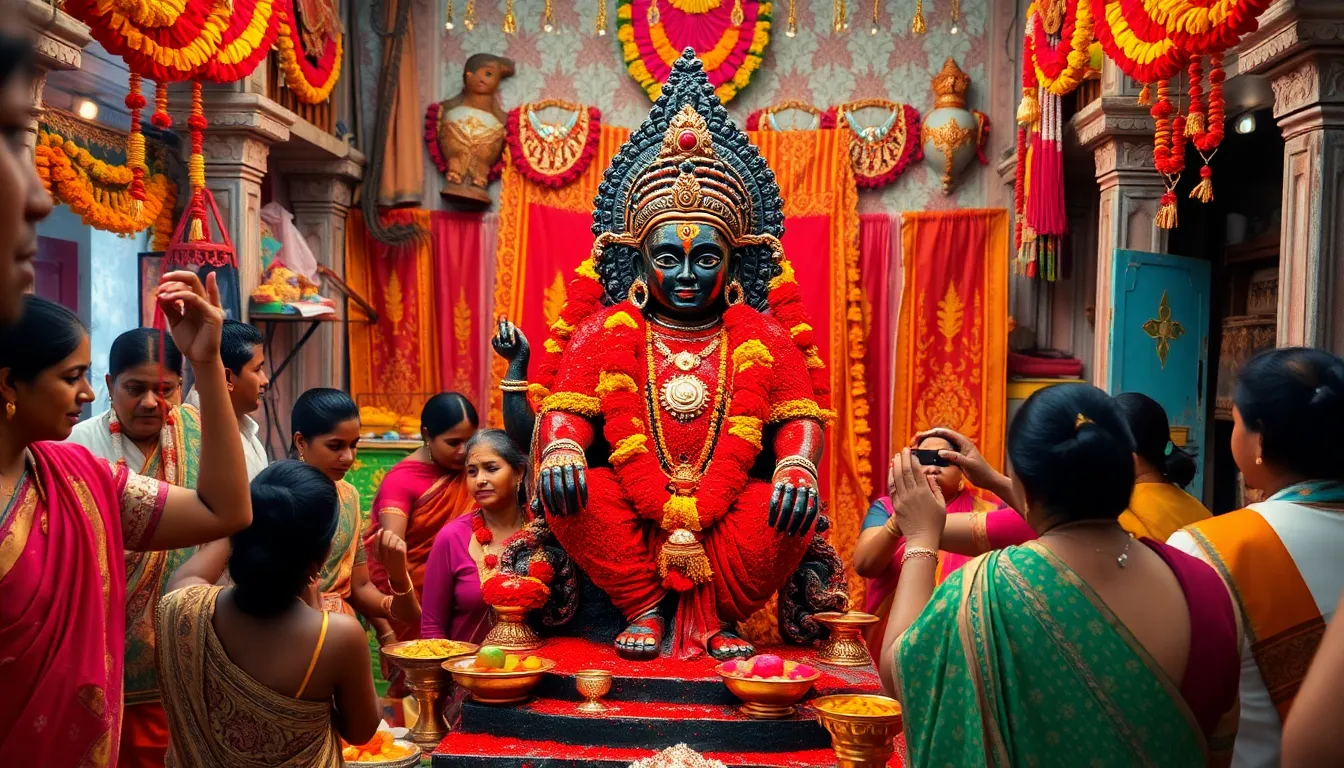Gowthalamma stands as one of South India’s most revered folk deities, captivating devotees with her fascinating origin story and powerful presence in local spiritual practices. Often depicted with multiple arms and adorned in vibrant red garments, she’s both a protective maternal figure and a fierce guardian against evil forces.
Her temples dot the landscapes of Andhra Pradesh and Tamil Nadu, where thousands gather annually to celebrate festivals dedicated to her divine power. What makes Gowthalamma particularly intriguing is how she’s seamlessly blended into the fabric of daily life—appearing in everything from traditional folk songs to modern pop culture references.
Whether you’re a spiritual seeker, cultural enthusiast, or simply curious about diverse religious traditions, Gowthalamma’s story offers a fascinating glimpse into the rich tapestry of Indian folk religion that continues to thrive in today’s rapidly changing world.
Table of Contents
ToggleWho Is Gowthalamma: The Divine Mother Goddess
Gowthalamma embodies the divine feminine energy revered across South Indian communities as a powerful mother goddess. Often depicted with multiple arms holding weapons and protective symbols, she’s characterized by her fierce yet nurturing presence. Her distinctive appearance includes vibrant red attire, a commanding posture, and ornate jewelry symbolizing her divine status.
In Hindu folk traditions, Gowthalamma represents protection against malevolent forces and pestilence. Local legends describe her as emerging from divine intervention during times of great suffering, specifically to guard villages from disease and calamity. Many devotees consider her an avatar or manifestation of Goddess Parvati, connecting local worship practices to broader Hindu mythology.
Anthropological studies reveal that Gowthalamma worship dates back several centuries, evolving from indigenous tribal beliefs that merged with mainstream Hinduism. Her cult gained particular prominence during historical periods of epidemic outbreaks when communities sought divine intervention against invisible threats. Followers attribute miraculous healing powers to her, especially regarding ailments affecting women and children.
Rural communities throughout Andhra Pradesh, Tamil Nadu, and parts of Karnataka maintain sacred spaces dedicated to Gowthalamma. These range from elaborate stone temples to simple village shrines marked by vermilion-painted stones. Devotional practices involve offerings of flowers, coconuts, incense, and occasionally animal sacrifices during major festivals.
Gowthalamma’s theological significance extends beyond protection, encompassing fertility, abundance, and cosmic balance. Her worship represents the enduring importance of feminine divine principles in Indian spiritual traditions despite historical patriarchal influences. Modern interpretations see her as embodying feminine strength, resilience, and the nurturing aspects of divinity that sustain communities through hardship.
Historical Origins of Gowthalamma Worship
Gowthalamma worship traces its roots to ancient South Indian folk traditions that evolved over centuries. Archaeological evidence suggests that her veneration began as localized village rituals that gradually formalized into established worship practices during periods of societal crisis.
Regional Variations in South India
Gowthalamma worship exhibits distinct regional characteristics across South India. In coastal Andhra Pradesh, she’s known as “Poleramma” and associated with protection from smallpox, with temples featuring unique black stone idols adorned with vermilion. Tamil Nadu devotees call her “Mariamman” and emphasize her connection to rain and fertility, celebrating her with elaborate water rituals during summer months. Karnataka’s interpretation, “Yellamma,” incorporates agricultural symbolism into worship practices, particularly during harvest festivals. Kerala communities recognize her as “Bhadrakali,” focusing on her warrior aspects through kathakali performances depicting her triumph over demons. These regional variations reflect how local communities adapted core beliefs about the goddess to address specific environmental and social concerns.
Connection to Ancient Mother Goddess Traditions
Gowthalamma worship connects directly to Neolithic-era mother goddess cults found throughout the Indian subcontinent. Archaeological excavations in South India have unearthed female figurines dating back to 3000 BCE, displaying attributes strikingly similar to modern Gowthalamma iconography—multiple arms, protective postures, and fertility symbols. Scholars from Oxford University’s Department of Anthropology have identified clear parallels between Gowthalamma and pre-Vedic goddess Aditi, considered the cosmic mother in ancient texts. Linguistic analysis of devotional songs reveals terminology connecting her to Dravidian earth goddess concepts predating Sanskrit influence. The goddess’s association with disease control mirrors ancient Harappan cultural practices where female deities served as protectors against epidemics. This continuity demonstrates how indigenous spiritual traditions maintained their core elements while adapting to changing religious landscapes over thousands of years.
Religious Significance of Gowthalamma
Gowthalamma occupies a central position in the spiritual landscape of South Indian communities, embodying divine protection and maternal care. Her worship represents a living tradition that connects devotees to ancient beliefs while addressing contemporary needs for spiritual security and communal identity.
Rituals and Ceremonies
Devotional practices dedicated to Gowthalamma follow intricate ritualistic patterns established over generations. Puja ceremonies begin with the purification of the temple grounds using turmeric water and sacred ash. Devotees bring offerings of red flowers, coconuts, kumkum, and specially prepared sweets that priests consecrate before the deity’s image. During annual festivals, particularly in summer months, communities perform “Jatara” celebrations lasting 3-5 days with continuous chanting, devotional music, and processions carrying the goddess’s image through village streets. Female oracles known as “Matangi” sometimes enter trance states, believed to channel the goddess’s presence and deliver prophecies or blessings. Many rural communities maintain traditions of animal sacrifice during major celebrations, though vegetarian alternatives have become increasingly common in urban temples.
Sacred Symbols Associated with Gowthalamma
Iconography surrounding Gowthalamma incorporates distinctive symbols that communicate her divine attributes and powers. Tridents (trishul) represent her connection to Shiva’s consort Parvati and her authority over the three realms of existence. Red cloth banners adorn her temples, symbolizing her fierce protective energy and association with life-giving blood. Clay pots filled with sprouting grains appear frequently in her worship, signifying fertility and agricultural abundance under her guardianship. Lamps burning with specific oils create sacred light believed to dispel negative energies from the temple space. Devotees mark their foreheads with vermilion dots after worship, carrying her protective essence with them. Ceremonial masks depicting the goddess’s face serve as powerful conduits during ritual performances, allowing devotees to embody aspects of her divine presence during temple festivals and community celebrations.
Temples and Sacred Sites of Gowthalamma
Gowthalamma’s spiritual presence manifests physically in numerous temples and sacred sites across South India. These sacred spaces serve as focal points for community worship and perpetuate centuries-old traditions dedicated to the powerful mother goddess.
Famous Pilgrimage Destinations
The Sri Gowthalamma Temple in Tadepalligudem stands as the most prominent pilgrimage site for devotees, attracting thousands during annual festivals. Located in West Godavari district of Andhra Pradesh, this temple features distinctive architecture with intricately carved stone pillars and a sanctum housing the goddess’s main idol adorned with vermilion and flower garlands. Devotees from neighboring states travel to the Gowthalamma shrine in Tirupati, renowned for its healing powers particularly related to skin ailments and fertility blessings. The coastal Gowthalamma temple in Nellore becomes the epicenter of spiritual activity during the summer months when special rituals are performed to invoke rain and prosperity. Rural pilgrimage routes connect multiple village shrines throughout Tamil Nadu, forming a sacred geography where devotees complete journeys on foot as acts of devotion. Each site maintains unique local traditions while preserving the core elements of Gowthalamma worship that date back centuries.
Modern Worship and Cultural Impact
Gowthalamma worship has evolved significantly in recent decades, adapting to contemporary South Indian society while maintaining its traditional spiritual core. Her influence extends beyond religious practices into cultural expressions, social identity, and community cohesion in the digital age.
Festivals Celebrating Gowthalamma
Gowthalamma festivals represent vibrant communal celebrations that blend ancient rituals with modern expressions of devotion. The annual “Gowthalamma Jatara” transforms villages and towns into colorful spectacles with processions featuring the goddess’s decorated idol carried through streets on flower-adorned palanquins. Devotees participate in “Alankarams” (divine decorations) where the deity receives different ornate appearances each festival day. Traditional folk performances like “Kolatam” (stick dance) and “Tappetagullu” (drum performances) accompany these celebrations, drawing tourists and anthropologists alongside worshippers. Many communities organize “Palabhishekam” ceremonies where the goddess’s idol receives milk baths, followed by communal feasts that serve as important social bonding rituals across caste and class divisions.
Gowthalamma in Contemporary Art and Media
Gowthalamma’s image has transcended traditional worship contexts to appear across multiple modern media platforms. Contemporary South Indian filmmakers incorporate her symbolism in movies exploring themes of justice and female empowerment. Popular television serials regularly feature storylines centered around her miraculous interventions, introducing younger generations to her mythology. Digital artists create modern interpretations of the goddess for social media sharing, often emphasizing her fierce protective aspects that resonate with women’s rights movements. Folk musicians have adapted traditional Gowthalamma devotional songs into fusion compositions that attract international audiences through streaming platforms. Fashion designers incorporate elements from Gowthalamma iconography into contemporary clothing lines, particularly red textile patterns and symbolic motifs that reference her protective powers while connecting traditional spirituality with modern aesthetic sensibilities.
The Protective Powers Attributed to Gowthalamma
Gowthalamma’s devotees attribute numerous protective powers to this revered deity, believing she shields communities from disease, natural disasters, and evil forces. Her divine protection extends particularly to children and pregnant women, with many families conducting special prayers during childbirth complications. Farmers seek her blessing before planting seasons, trusting her influence over agricultural prosperity and protection from crop diseases.
Villages experiencing epidemics often conduct special rituals called “Gowthalamma Bonalu,” where communal offerings are presented to pacify the goddess and stop the spread of illness. These ceremonies typically involve the sacrifice of chickens or goats, with blood offerings considered especially potent in invoking her protective intervention. Many devotees wear talismans bearing her image—small copper pendants or red thread bracelets—as constant personal protection.
Historical records document numerous instances where communities credit Gowthalamma with ending smallpox outbreaks and cholera epidemics. Her protection against snakebites remains a significant aspect of her worship, with special mantras chanted specifically for this purpose. Local healers often invoke her name while treating patients, believing her divine energy flows through traditional medicines and treatments.
Devotees consider the sacred ash from her temple fires (vibhuti) particularly powerful, applying it to the forehead for protection against negative energies and illness. Household shrines dedicated to Gowthalamma feature prominently in many South Indian homes, serving as focal points for daily prayers seeking her continuous guardianship. Rural communities maintain the tradition of painting her symbolic eyes on doorways and entrances, creating a protective boundary that prevents malevolent forces from entering the home.
Conclusion
Gowthalamma stands as a powerful testament to the enduring nature of South Indian folk religion. Her worship bridges ancient traditions with contemporary needs while providing spiritual security to countless devotees across generations.
Through vibrant festivals regional variations and intimate household practices her presence continues to shape cultural identity and community bonds. The goddess embodies the divine feminine that has remained relevant despite modernization.
As both protector and nurturer Gowthalamma reflects the remarkable adaptability of indigenous spiritual traditions. Her continued veneration demonstrates how deeply rooted folk deities remain in the collective consciousness even as society evolves around them.
The Gowthalamma tradition reveals the living breathing nature of South Indian spirituality where ancient goddesses continue to guard guide and inspire their devotees.




